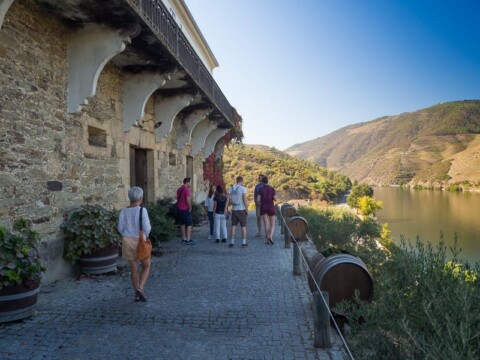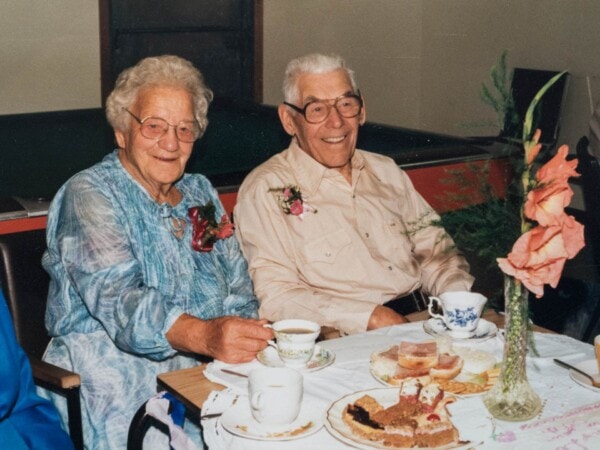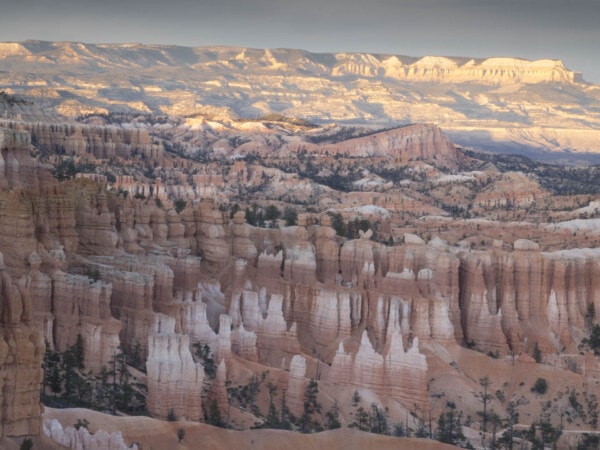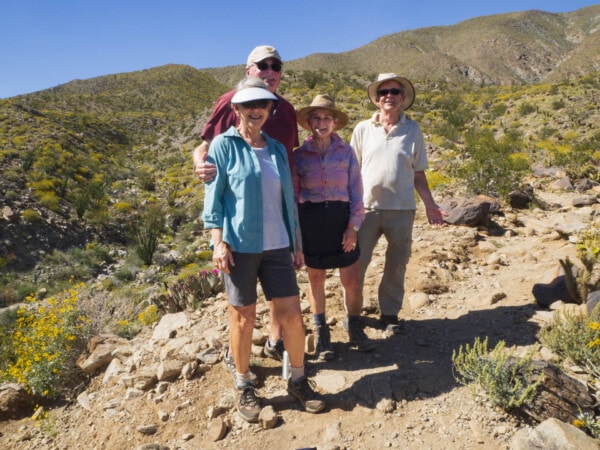Years ago when people thought only les vins français were worth drinking, our neighbour Jim started a little company importing wine from Spain and Portugal. When his son visited this month and inventoried the remaining bottles, I thought back to two Januaries ago and a eulogy at Jim’s Celebration of Life. “I knew nothing about wine,” said his business partner Scott. “But Jim told me wine regions attract interesting characters and convinced me, via our many trips together, that wherever you have good wine, you’re also certain to find good food.” Now that’s worth thinking about when you’re planning a trip somewhere isn’t it?
Which took us to Portugal’s Douro Valley, designated UNESCO World Heritage status in 2001.
When planning our trip, Magellan lived up to his name by discovering Quinta da Marka. “Look at this. It’s up high on the north side of the river, the quieter part of the Douro, with amazing views. And it’s small, only seven rooms,” he indicated.
Driving the N222 from Porto, he said, “Look, there’s our hotel across the river. About five minutes away if we were in a boat.” But in our rental car, an hour’s drive with breathtaking views of terraced vineyards edged by white-washed walls of stone on a dizzying road (that had us gasping for breath) as twisty as the trunks on century-old old vines, a road so small it has a hyphen: CM 1268-1. Here’s how Kevin Gould in The Guardian describes them.
But be warned: these roads are for confident drivers only. They are intestinally curly. Climbs are crazily steep. Cliffs must be tightly hugged and other vehicles may well be kissed. Safety barriers seem anathema. Most roads are breathe-in thin.
At the Quinta, we were greeted by Diamantino, a name that made me think, “small diamond.” That he was, efficient not officious, dressed in blue jeans and T-shirt. “I’m the only one here who speaks English and I leave soon until tomorrow morning, so ask me anything you want now.”
It’s not likely you’ve heard of Quinta da Marka even though it’s been around since 1756. Their annual production is only 150,000 bottles. And guess where most of it’s exported? The UK? No. The US? No, that’s number eight on the list. China? It’s number two. Angola imports 80% of Quinta da Marka’s wine. Go figure.
The 35-acre property on the right hand bank of the Douro River belongs to the family of José Carlos Agrellos. The land, mainly south-facing, has vines older than us and a Grade A classification going back to the 18th century. In 2008, the family rebuilt the winery and in 2012, completed the Quinta. The name Marka is a tribute to family matriarch MARjorie KAthleen. For such a small property, they grow a surprisingly large variety of grapes, like Touriga Nacional, Tinta Roriz, Touriga Franca and Tinto Cão—we drank a bottle blended with 18 different varieties. Descriptions of their wines are refreshing. “Dark violet colour. Fresh pure damson aroma. Light floral tannins and balanced acidity. A wine that’s not trying too hard.”
The latter describes the Quinta’s understated country-casual elegance. Our room, the smallest and on the lower level of the two-storey house, had a peek of the Douro, though miniscule compared with the incredibly picturesque views from the grand deck on the main floor. Overstuffed sofas, large windows and plenty of interesting reading material about the Douro made the living room inviting. Dinners were traditional, unfussy Portuguese cooking. Roast chicken. Sea Bream. Octopus. Served with a complimentary bottle of wine and glass of the country’s best port (Noval).
It was a hot October afternoon so after we checked in, Magellan and I ordered a bottle of Aromas da Vinha, an exotic (to us) blend of Gouveio, Viosinho, Malvasia and Fina Moscatel, and headed for the outdoor patio overlooking the undulating curves of terraced vineyards hanging above the Douro. We spoke of Jim and wondered if he’d been here. He’d have liked the character of the place.
As the sun moved, so did we, back up to the main terrace, where we were soon joined by another couple. “Hi, I’m Bill and this is my wife Jo. I overheard you talking earlier and figured you know what to do in this area. Where are you two going next?” As the shadows deepened, so did our conversation.
Have you ever talked to people who have lived through a natural disaster? Hurricane Katrina hit New Orleans when Bill was still living there—the day after his first wife’s funeral. Although the family home was on high ground, he headed for Memphis with eight or so house guests. A few days later he returned, illegally, to see what damage his coffee business had undergone. “Everything was floating and when I opened the door to the green room, I could see that the rats had taken over.” I couldn’t resist asking how he and Jo had met. “Match.com,” answered Bill, “and coincidentally, Jo grew up in the same area in Wisconsin as my first wife.”
Instead of driving the CM 1268-1, you could take the train, which stops a kilometre away from the Quinta at the tiny railway “station” at Ferrão, which in 1880 was the end of the Douro Line. Ferrão gives new meaning to the phrase “whistle stop.” But look at the railway station in Pinhão—the most beautiful one we’ve ever seen, brilliantly adorned with storytelling ceramic tiles.
I’d read about Talho Qualifier, a butcher chop on Pinhão’s main street, and since we were going to Talasnal (remember that story?) where we could cook, I wanted to check it out the next morning. Talho Qualifier, not much wider than a railway car, is so tiny we walked by it at least twice. As we waited in line, a hearty guy I assume was Fernando Rebelo, the proprietor himself, offered us a glass of homebrew poured from the spout of a little stainless steel vessel with a white collar indicating, we deciphered, that it could only be consumed on the premises. We were in the mood for sausages, cheeses and pork spareribs, easy to identify in the showcase. “The kebabs look good but what‘s the meat?” I asked Magellan. We inquired but no one in the shop spoke English. Then one of the women behind the counter smiled and began pantomiming a flying motion accompanied by sound effects. Chicken? No. Duck? No. The French woman who owned the shop next door was summoned. “Dindon!” Smiles and laughter all round. Then Fernando said something in Portuguese, slapped the side of his head and brought out the raw turkey itself—fresh kebabs indeed.
Thanks to Diamantino, we stopped at Quinta do Tedo, an organic winery where he used to work. We did a tasting tour and ate delicious tapas (squid and chorizo croquettes, vegetable curry and cod carpaccio) served outdoors overlooking the Tedo River. We haven’t opened the bottle of port we bought there, but when we do, we’ll drink a toast to Jim, to the characters we met in the Douro and to our next wine country trip—Sicily.
Navigation
Gould, Kevin. “Ports of Call: a wine tour of the Douro.” The Guardian. May 21, 2016. A rollicking account of a Brit’s tour with the Douro Boys.
Magellan found the website of Julie Dawn Fox, whom we thank for providing us with a lot of info for planning our trip to Portugal. Here’s her advice on the Douro.
Quinta da Marka, E.N. 322-2, Lugar Do Ferrã, Covas do Douro, Norte is a great place to stay in the Douro wine country.





























5 Responses
I have been to the wine country once on the launch of this new brand for rose wine. I really fell in love with the place and decided that one day I will open my own winery in the same place.
Really enjoyed reading about this wine/port area. Pictures are amazing. Quinta da Marka looks like an oasis, so quaint. Must get to Portugal one of these days.
Thanks for the sunny read on yet another dreary day in Vancouver.
Reminded me a little of our trips to Osoyoos—much more rugged land in the Douro, which would be gorgeous dressed in green in the spring—but equally blessed with interesting characters and excellent food. And wine, of course.
Love the colours behind you both on the terrace and also from the tiles, amazing.
Reminds me very much of the Okanogan only much steeper country and a lot less hectic, perfect.
Do not see enough print about Port, a favourite of mine, dark and deep in texture, almost mysterious in nature, awakens the taste buds, most excelant on the ski hill, from a wine skin of course. ⛷?
Cheers
OK, you asked for it!
Here’s a blurb about the world’s best port—Quinta de Noval, Nacional 1931. (We tasted a flight of four of their less-valuable ports at their establishment in Oporto.)
Price: Sold at Christie’s in 2006 for £4,840
From Decanter: “For Michael Broadbent, this is ‘the Everest of vintage Ports’. In 1982 he said: ‘I noted its amazing high-toned bouquet which reminded me of eau de cologne, Armagnac, and a sort of ultra-refined liquorice. Although only medium-sweet, it was incredibly full-bodied, a rich, bittersweet wine, spicy, of great length.’ James Suckling in 1989 noted: ‘The Port is still incredibly rich and youthful… with a focused chocolate and cherry nose, medium-bodied, with great balance, a superb concentration of fruit and a never- ending finish.’ In 2002 Clive Coates MW summarised his six encounters with the wine over the previous decade: ‘The colour is still an intense black-purple. The nose is creamy rich, crammed with very high quality fruit, and on the palate there is an intensity coupled with a class which seems effortless. But the finish! Few wines have this length and this complexity. A really very great wine.’ In 2004 Port blogger Roy Hersh wrote: ‘Amazing depth of flavours prevailed… overwhelming intensity to the sweetness of the juice.’ Wine collector Cary Feibleman wrote, in an article on his favourite wines in The Underground Wineletter: ‘One of those 21-out-of-20 point wines for incredible richness, concentration, complexity and a finish that goes on for five minutes.”